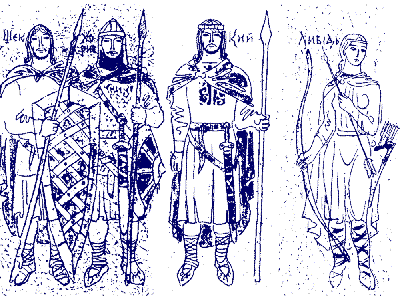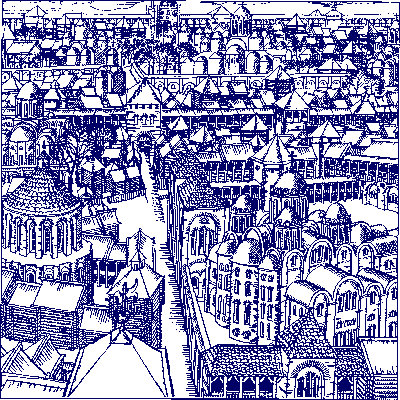
|

|
ONCE UPON A TIME there was a royal family of three brothers. One was named Kie, the second was Shchek, the third Khoriv and they had a beautiful sister called Lebid. They had lost their mother and father to invaders from the East and were searching for a place to make a new home.
When they arrived at the beautiful blue Dnipro River, and saw the seven majestic green hills across the river covered with kashtan trees and flowers, Kie chose the place as their new home.
Kie and his brothers built a boat and then sailed across the broad and mighty Dnipro River towards the high green bank on the western side. But what should be the name of the new Metropolis? Kie's brothers and sister decided to name the new city KYIV in honor of their strong and brave elder brother, King Kie. Thus it was that the City of Kyiv was founded on the last weekend in May, in the Spring of the year 482 A.D.
Kie ruled on the hill which is now called Borichev, Shchek settled on the hill which is now called Shchekovitsa, and Khoriv settled on the third, which after him was called Khorevitsa. And it was thus that they founded the great city over 1,500 years ago.
In ancient days this was the land of the Trypilians, Cimmerians, Scythians, Sarmatians, Alans, Antae, Roxolanians and the legendary Amazon women. The ancient Greek historian Herodotus, "the Father of History" wrote that Hercules himself had founded this land.
According to legend here was the very place, the Starokievska Hill, where the Apostle Saint Andrew, centuries earlier came as a missionary to Scythia. He had raised a cross on the hills of Kyiv and predicted that here a great city would rise one day with many churches to the glory of God. And so the prophecy was fulfilled.
Merchants and craftsmen from far and wide soon gathered by the Dnipro River and settled in the Podol, the lower town, which became the center of commerce. Kyiv slowly grew through the centuries into the great, majestic and Royal City of Kyiv.
It was in 988, five centuries after the founding, that King Vladimir Christened his Slavic nation, the Ukrainian people of Rus'-Ukraine. It was here, where the broad street Khreshchatik still marks the place, that the people descended from the hills into the Dnipro River to be Christened into the Christian Church by Greek priests from Constantinople the capital of the Byzantine Empire.
King Vladimir built the Desyatina Church, and in 1036 his son, King Yaroslav, built Saint Sophia (Holy Wisdom) Cathedral as a sister of the famous Hagia Sophia in Constantinople. Saint Sophia in Kyiv became the Mother Church of Ukraine, and for a thousand years the immortal gold mosaic wall of the Virgin Oranta has watched over Kyiv. The Mongol invasion of 1240 and many since then did not destroy this "invincible wall" of Kyiv. St. Michael the Archangel protected this saving remnant of Kyiv's days of golden glory.
It was in the year 1187 that for the first time in history the historical chronicles mention the new name Ukraine for the ancient name of this land, which was Rus'.
Centuries later, in 1492, the Cossacks of Ukraine, the famous Zaporozhians, came into history as defenders of the Christian Church and the Ukrainian nation from Tatar, Turkish, Polish and Russian invaders. And as Taras Shevchenko, the great poet, said in The Dream: "The First (Tsar Peter I) racked my country dear, The Second (Catherine II) gave the final blow, That brought my land to utter woe...
Shevchenko's "sad Ukraine" has now been reborn in the world "family of free nations". And this city of Kyiv, the capital of the ancient Rus Kingdom, which is one of the most beautiful cities in the world today, has become the great gold-topped capital of democratic, free and independent Ukraine.

|
Plaque created for the 1500th Anniversary of Kyiv celebrated in 1982. It features a sculpture of Kie, Shchek, Khoriv and Lebid in a ship which is on the Dnipro River bank. |
In 1982 the City of Kyiv celebrated its 1,500th Anniversary, however we know that the city existed long before that. The original chronicle version of the founding of Kyiv in the Povist vremennykh lit is reflected in paragraphs 1, 3 (except the date), 4 and 5. Archeologists have found stone age (late paleolithic) remains but the oldest dwelling in Kyiv is from the 25th century B.C., about 4,500 years ago, so Kyiv was inhabited long before King Kie. However, according to some historians King Kie (or Kyi) was a real person who ruled the Polianians and lived in the 5th century A.D.
The English form of the name Kyiv, based on Old Ukrainian, goes back centuries while the modern name is spelled Kyiv in Ukrainian. The Government of Ukraine favors the use of the form Kyiv by its government agencies but Kyiv is still the common usage in the English speaking world today.
Northwestern Ukraine, including Kyiv, is thc original homeland of all the Slavic peoples so Kyiv perhaps represent the oldest Slavic citv. Thc Slavic tribes which lived on the territory of present day Ukraine and who are probably the ancestors of the Ukrainian nation include the Polianians, Drehovichians, Siverians, Drevlianians, Volynians, Dulibians and Ulichians. Northwestern Ukraine is also considered by many scholars as the birthplace of the Indo-European peoples or languages. Kashtan trees are chestnut trees for which Kyiv is famous in the Spring. The Lebid River flowing through Kyiv today to the Dnipro was named in honor of the sister of Kie. Saint Andrew is the patron Saint of Ukraine. St. Michael, the Archangel, is the patron saint of the City of Kyiv.
King Vladimir is sometimes known as Velyky Kniaz in Ukrainian which is often mistranslated as Grand or Great Prince. Since Kniaz a cognate ot the word King this is the correct term for English speaking countries. There are many St. Vladimir Churches in the world some of which use the modern Ukrainian spelling of Volodymyr. Khreshchatik, litetally Christening Street, is the majestic main street ot Kyiv today. The foundation stone outline of the Desyatina (Tithes) Church may still be seen today in front ot the Historical Museum near St. Andrew's Cathedral.
The Dnipro River, which flows through the heart of Ukraine, is often found in the old Greek form Borysthenes on old maps or as Dnieper on modern maps. It comes from the Iranian word don or dan meaning 'river' as in Danube, Dnister, Donets and the Don Rivers. Ancient Rus' should not be confused with Russia, a completely separate name which centuries later (after 1710), on Tsar Peter I's orders, replaced the original name Muscovy. Today it is actually spelled Rossia in Russian. Ukraine declared its sovereignty in July 1990 and its independence on August 24,1991, before the USSR disappeared. Today Ukraine is a nation of 52 million with the largest territory of any country in Europe.

|
Kyiv. The main area of the upper city of King Vladimir with the Desyatina Church, bottom right, built before the year 1000 A.D. By H. Lohvin. |
![]() Return to FORUM: A Ukrainian Review Page
Return to FORUM: A Ukrainian Review Page
Copyright © 1992-1999 Andrew Gregorovich